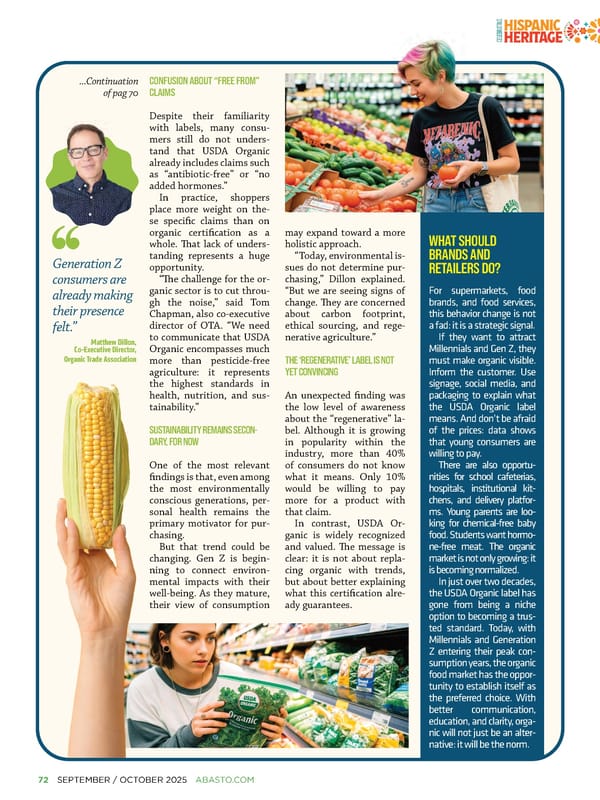72�SEPTEMBER / OCTOBER 2025�ABASTO.COM CONFUSION ABOUT “FREE FROM” CLAIMS Despite their familiarity with labels, many consu- mers still do not unders- tand that USDA Organic already includes claims such as “antibiotic-free” or “no added hormones.” In practice, shoppers place more weight on the- se specifc claims than on organic certifcation as a whole. Tat lack of unders- tanding represents a huge opportunity. “Te challenge for the or- ganic sector is to cut throu- gh the noise,” said Tom Chapman, also co-executive director of OTA. “We need to communicate that USDA Organic encompasses much more than pesticide-free agriculture: it represents the highest standards in health, nutrition, and sus- tainability.” SUSTAINABILITY REMAINS SECON- DARY, FOR NOW One of the most relevant fndings is that, even among the most environmentally conscious generations, per- sonal health remains the primary motivator for pur- chasing. But that trend could be changing. Gen Z is begin- ning to connect environ- mental impacts with their well-being. As they mature, their view of consumption Generation Z consumers are already making their presence felt.” Matthew Dillon, Co-Executive Director, Organic Trade Association may expand toward a more holistic approach. “Today, environmental is- sues do not determine pur- chasing,” Dillon explained. “But we are seeing signs of change. Tey are concerned about carbon footprint, ethical sourcing, and rege- nerative agriculture.” THE ‘REGENERATIVE’ LABEL IS NOT YET CONVINCING An unexpected fnding was the low level of awareness about the “regenerative” la- bel. Although it is growing in popularity within the industry, more than 40% of consumers do not know what it means. Only 10% would be willing to pay more for a product with that claim. In contrast, USDA Or- ganic is widely recognized and valued. Te message is clear: it is not about repla- cing organic with trends, but about better explaining what this certifcation alre- ady guarantees. WHAT SHOULD BRANDS AND RETAILERS DO? For supermarkets, food brands, and food services, this behavior change is not a fad: it is a strategic signal. If they want to attract Millennials and Gen Z, they must make organic visible. Inform the customer. Use signage, social media, and packaging to explain what the USDA Organic label means. And don’t be afraid of the prices: data shows that young consumers are willing to pay. There are also opportu- nities for school cafeterias, hospitals, institutional kit- chens, and delivery platfor- ms. Young parents are loo- king for chemical-free baby food. Students want hormo- ne-free meat. The organic market is not only growing: it is becoming normalized. In just over two decades, the USDA Organic label has gone from being a niche option to becoming a trus- ted standard. Today, with Millennials and Generation Z entering their peak con- sumption years, the organic food market has the oppor- tunity to establish itself as the preferred choice. With better communication, education, and clarity, orga- nic will not just be an alter- native: it will be the norm. ...Continuation of pag 70
 Abasto Magazine: September/October 2025 ENGLISH Page 87 Page 89
Abasto Magazine: September/October 2025 ENGLISH Page 87 Page 89